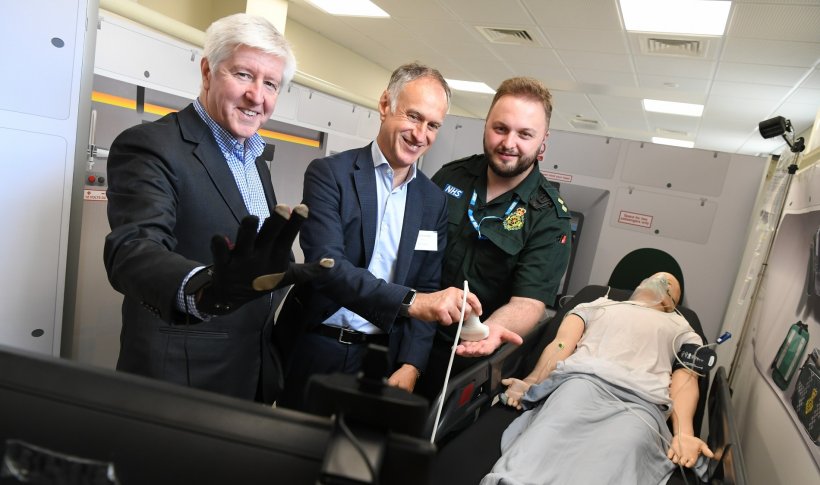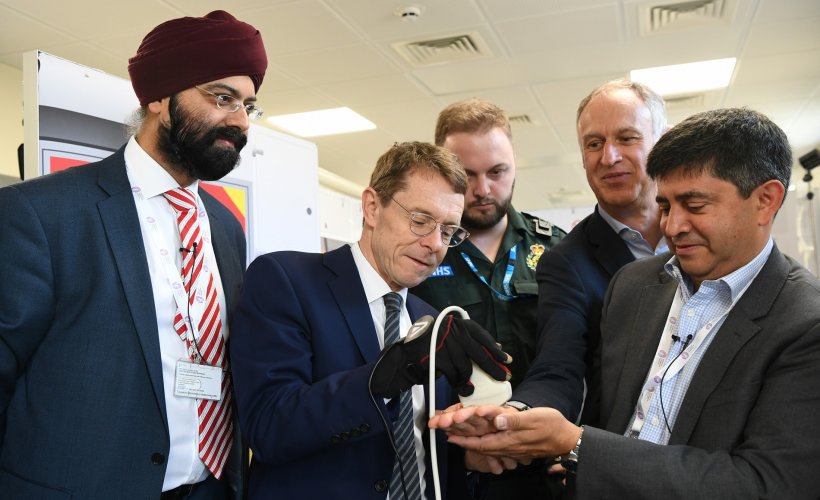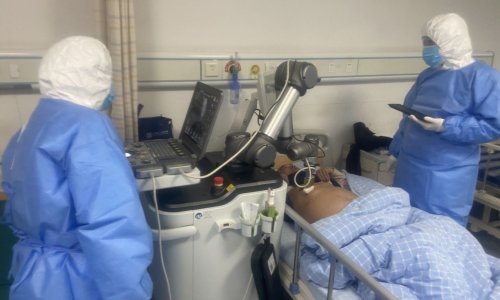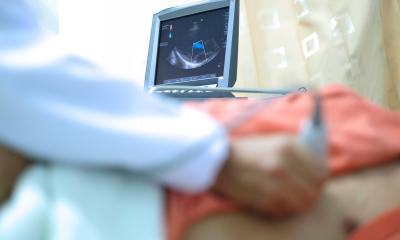
Article • UK tests high-speed remote medical diagnosis
Ultrasound scanning via a 5G network
To demonstrate advances in 5G connectivity for healthcare, a UK team has linked a paramedic in a simulated ambulance to a hospital-based clinician. The paramedic wore a robotic or ‘haptic’ glove, which received signals over the live 5G network.
Report: Mark Nicholls
Using a joystick, the clinician remotely directed the paramedic to move the ultrasound sensor to where on the patient the clinician wanted to scan. From this examination, high-quality ultrasound images were transmitted to the clinician in real-time, over the high-bandwidth 5G connection. In addition, a camera in the ambulance transmitted images of the paramedic and the patient to a second screen at the clinician’s workstation to offer an overall view.
In the future, our clinicians will be able to deliver holistic specialist advice in real time, potentially forming virtual multi-disciplinary teams to provide the best patient care using intelligent IT links
Tim Jones
WM5G – which aims to accelerate deployment of the infrastructure needed for 5G, and is building health, industry and mobility testbeds in the West Midlands region – pointed out the benefit of enabling ultrasound scans to be performed in the field, and reviewed remotely, facilitates quicker diagnosis and onward treatment.
The demonstration was hosted by the Medical Devices Testing and the Evaluation Centre (MD-TEC), in the University Hospital Birmingham (UHB) simulation lab, at the Institute of Translational Medicine, along with British Telecom (BT), the West Midlands Ambulance Service, and WM5G. ‘5G will help us to roll out this next generation of healthcare technologies,’ said Tim Jones, UHB Chief Innovation Officer. ‘In the future, our clinicians will be able to deliver holistic specialist advice in real time, potentially forming virtual multi-disciplinary teams to provide the best patient care using intelligent IT links.’
Recommended article

Article • Mobile data transfer
5G makes tele-surgery fit for the future
A 4G symbol next to the signal strength bar on a smartphone assures fast data transmission. 5G, the next generation of technology, is already waiting in the wings and could herald a new era for tele-surgery, PD Dr. Michael Kranzfelder is convinced. However, there are a few obstacles to overcome first.
Doing what you cannot do with 3G or 4G
Dr Omkar Chana, WM5G programme director, added: ‘The ultrasound demonstration was a flavour of what we can really do with 5G. You cannot do that with 3G or 4G. And, although it was 5G ultrasound, what we are demonstrating can lend itself to any aspect of clinical imaging and real time communication. Also, it does not have to be in an ambulance, it can be in a care home, or GP surgery, and the image quality is just as good as it would be in a hospital.’

The NHS long-term plan
Technological solutions – driven by 5G - are at the forefront of the latest NHS Long Term Plan as the NHS endeavours to meet the challenges of increased demand and an ageing population. ‘With low latency and the ability to communicate in real time, coupled with faster speed, massive amounts of data can be put through. With ultrasound, the clinician can see everything in real time. If he says “move left”, the paramedic in the ambulance moves the probe left – immediately,’ Chana observed. ‘It means the clinician can decide that the patient may not actually need to go to hospital, or may need to be taken to hospital quickly and go straight into surgery because of what they see on scan.’
Profiles:
Dr Omkar Chana is programme director for citizen wellbeing at WM5G, covering health and social care and the emergency services. With a PhD in physics, his career has covered hi-tech data and analytics and business strategy specific to the NHS and healthcare, as well as mergers and acquisition.
Tim Jones is Executive Chief Innovation Officer at University Hospital Birmingham. He joined UHB in 1995, became Head of Service Improvement in 2002 and led the New Hospital Clinical Redesign Programme, before being appointed to the role of Chief Operating Officer in June 2006. In September 2008, he was appointed Executive Director of Delivery, which incorporates board level responsibility for Research & Innovation, Education and Workforce.
07.10.2019











